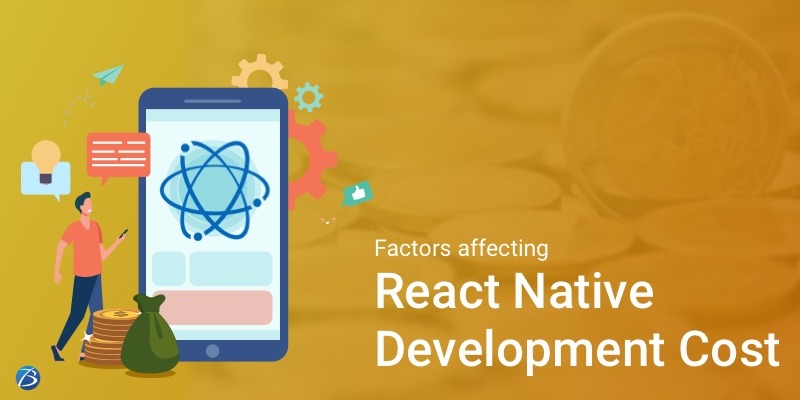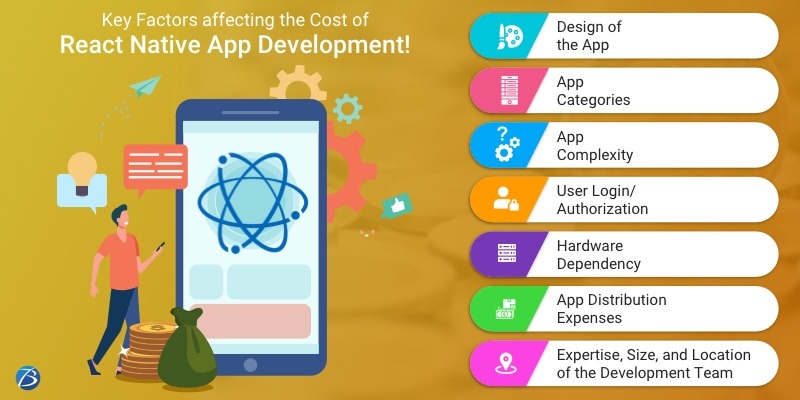ALL >> Technology,-Gadget-and-Science >> View Article
Key Factors Affecting The Cost Of React Native App Development!

The first set of questions that cross the mind of every aspiring entrepreneur planning to develop a mobile app are:
Which app development framework is profitable and most widely adopted?
What are the factors that influence the development cost?
What is the approximate cost during various stages of the project?
Well, React Native framework is one of the most viable options for developing applications. Its unique capabilities in comparison to the Native development options are:
• Code-sharing ability across multiple platforms
• Ability to craft responsive and fast-loading apps
• Availability of pre-built and reusable components
• Faster time-to-market
• Involves lesser resources and smaller teams
As per a developer survey conducted by Statista in 2020, “React Native is the most ...
... popular cross-platform framework used by 42% of the software developers around the globe.”
Now, you must be curious to know about all aspects concerning the development cost in React Native projects! Read along to gather insights on the factors affecting the React Native app development cost and also get a rough estimate of the expenses incurred during each stage of the project.
Factors affecting React Native Application Development Cost

The Design of the App
A well-devised app design is necessary to stay competitive. Devising a well-articulated user flow, well-timed animation, and smooth transitions for navigating between screens, enhances user engagement; but turns out to be super-expensive. Nonetheless, React Native App design costs lesser than that of Native apps; as only one app with cross-platform compatibility needs to be designed.
App Categories
The business requirement for each kind of application vary and so the elements like feature set, the number of real-time users, security considerations, etc. are different for each category of apps. Naturally, the development cost differs as per the number and type of intricacies employed. For instance, simple apps like calendars, calculators, etc. will involve lesser developmental costs as compared to complex, feature-rich apps like mCommerce or customized apps. The reason is integrating more features takes much longer than usual.
App Complexity
The entire mobile app development process usually takes about one week to six months to get completed. The time-to-market, as well as the developmental cost, is directly proportional to the level of complexity, number of functionalities, and the ingenuity of the features. For instance, a project involving the development of a simple app or MVP costs less and is much quicker to execute. Contrarily, a complex application possessing new-fangled features takes longer to develop and incurs more expenses.
All apps are categorized into three levels: High complexity, Medium complexity, and Low Complexity. The factors that determine the level of complexity are as follows:
The Architecture of Deployment Model: For backend development, you can either opt for the Custom approach or BaaS. The custom approach allows the React Native development companies to get the desired mobile architecture tailored to their specific needs; whereas those employing BaaS, have to function using a ready-made backend architecture.
Developing the Admin Panel: Admin panel enables app owners to efficiently manage the React Native app: keeping track of the app’s activity, viewing statistics, and updating the content without developer intervention. The more features you integrate into the Admin Panel, the higher the app ranks in the complexity chart.
Integrating third-party plugins: Integrating third-party plugins is necessary to make an app more user-friendly. These plugins allow the app to interact with other app’s functionality for simplifying processes such as login and payment. However, such integrations are more complicated to implement using React Native app development as compared to Native development.
Utilizing the Device's built-in features: The new-age tablets and smartphones are decked up with advanced features like GPS, Bluetooth, Barometers, Nearby, etc. which can be linked to an app for enhanced performance, thereby increasing the app’s complexity.
Adding in-app purchase: Most of the popular applications these days possess the ‘in-app purchase’ feature for accelerating ROI. So, app creators are tempted to include this feature, making the app more complex.
Integrating the app with Enterprise or Legacy System: A React Native app can either be a standalone or an integrated one. A standalone app functions independently without being integrated into your system and so is a budget-friendly option. But, the apps that are integrated within any of your enterprise/legacy systems; involve a series of complexities like third-party APIs, extensions, host system modifications in the app, etc. resulting in a more expensive development process.
User Login/Authorization
Crafting applications that do not need any type of user login/authorization and user authentication, involve lesser costs. Contrarily, an app providing these functions incurs more costs as it needs to undergo the process of role-based checks, set by developers. Moreover, the app’s complexity increases, as both the system development team and the app development team of the enterprise need to invest efforts for flawless development and deployment of the application.
Add-ons to the App
The React Native framework enables the creation of captivating apps. But, if one intends to develop a customer-centric app, that app has to be integrated with Social media channels or provided with other custom add-ons. These additional elements push up the expenses. Nevertheless, the need for add-ons depends on the preferences and requirements of clients.
Hardware Dependency
Certain applications like the IoT-powered ones need to be connected with different kinds of hardware. The more the hardware dependency of an application, the greater is the cost of development. Furthermore, utilizing React Native to create an app with hardware connections is more complicated as compared to the Native approach.
App Distribution Expenses
An app is usually deployed via distribution channels and each channel possesses a different pricing policy. The developer license cost charged by stores like the App Store or Google Play is somewhere around $100. Additionally, some apps require permissions from the host, concerning aspects like adherence to security policies, compliance of standards, etc.
Expertise, Size, and Location of the Development Team
The expertise of React Native app developers and the size and location of the development team define the project cost to a considerable extent. Take a look!
The hourly rate of experienced and skilled developers or a huge development team will be much higher, but they are capable of handling complex projects. Hiring freelancers, on the other hand, is a highly affordable option, but the work quality is often compromised. Therefore, opt for freelancers if your project is a simple one, with a flexible completion deadline and you have budget constraints. But, in the case of a complex project with a specified timeline, it is advisable to partner with a React Native App Development Company. Again, high-cap development firms will charge more as they have set high standards in the market. However, a mid-cap app development firm will be a good option to go for; as their hourly rate is comparatively lesser – 41 USD (approximately); and they are more open to executing innovative app ideas.
Besides, the rates vary as per the geographical location of the React Native app Development services you have hired for project execution. The hourly rates are higher in places like Australia, Europe, and North America and comparatively lower in places like Latin America, India, and other Asian countries.
React Native App Cost estimate
Here’s a rough estimate of the app development expenses through various stages.
• The discovery stage – validating app idea, competitive analysis, deciding the target audience, creating the roadmap – generally costs less than $ 5,000.
• Wireframing and prototyping including the creation of visual presentations and lo-fi sketches consume 40 – 50 hours approximately.
• The design and development stage comprises major functions like UI creation and implementation, front-end, and back-end development, testing, etc. As such this stage involves 50% to 70% of the overall developmental expenses.
• Maintenance and support post-launch – bug fixes, updates like revamping the design to keep up with changing trends, adding new features, etc. – are essential for user engagement and retention. This stage accounts for about 20-25% of the total development cost.
Key Takeaway:
The aforesaid insights on the advantages of React Native app development, the cost estimate, and the factors affecting the project cost will help you to choose the right option as per your specific requirements.
To know more about our other core technologies, refer to links below:
Add Comment
Technology, Gadget and Science Articles
1. Cloud Storage Providers In India | Cloud Computing Services In IndiaAuthor: Sathya Technosoft
2. The Future Of Multilingual Web Development: Smarter, Faster, Global
Author: Addxp Technologies
3. Bubbling Life Back Into Lakes: The Power Of Micro Nano Bubble Generators
Author: NICO Nanobubbles
4. Ai Call Centers: Boosting Efficiency, Reducing Costs, And Improving Customer Experience (cx)
Author: precallai
5. What Is The Future Of Blockchain Technology In India?
Author: DC Kumawat
6. Ice Line Freezer: Revolutionizing Cold Chain Storage In Laboratories And Healthcare
Author: kabir Digital
7. How To Scrape Product Info, Images & Brand Details From E-commerce Sites - A Complete Guide
Author: Real Data API
8. The Pros And Cons Of Outsourcing Mobile App Development
Author: Chloe Decker
9. It Helpdesk Provider Business – Reliable It Support In Singapore
Author: Entrust Network Services
10. Unveiling Florida's Premier Banner Printing Services: Quality And Affordability Combined
Author: printitusa
11. Transforming Hr Efficiency: Walkme For Human Capital Management
Author: Stephen Pech
12. 5 Best Ai Tools For Ai Marketing In 2025
Author: jatin
13. How Social Media Can Help You Grow Your Business
Author: jatin
14. Why Rooftop Solar Is The Smartest Investment For Your Home
Author: Seo Globo
15. Best Light Therapy Glasses For Better Sleep And Energy
Author: Joe Stewart








